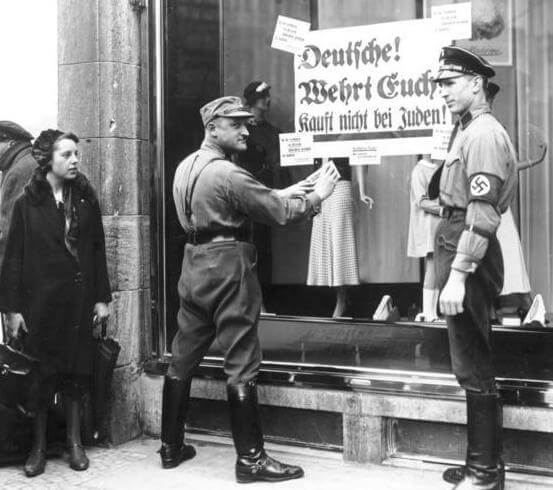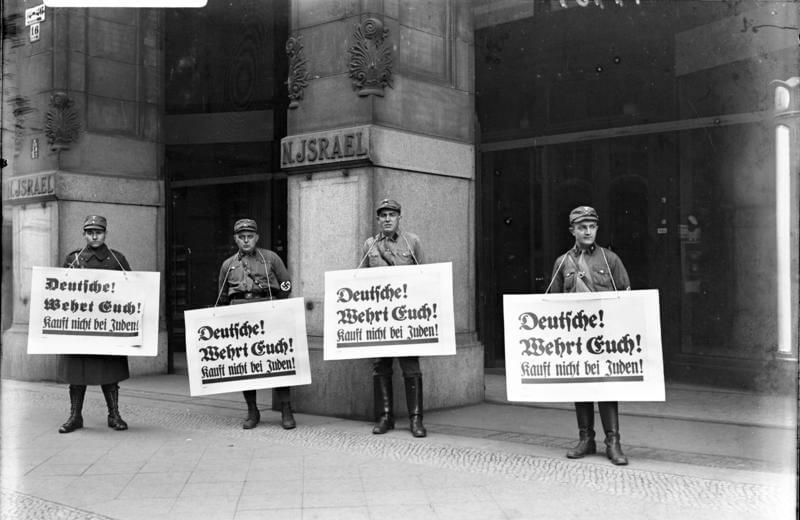
Ernst Leitz II, who headed the Leitz Company, makers of Leica cameras, between 1920 and 1956, covertly ushered untold numbers of Jews out of Nazi Germany in the 1930s and ’40s in what became known as the Leica Freedom Train.
[Leica Camera AG]
The German industrialist, whose father revolutionized photography with his iconic 35mm Leica rangefinder camera, and daughter Elsie Kuehn-Leitz started covertly “transferring” the firm’s Jewish workers to far-flung Leitz company offices in France, Britain, Hong Kong, the United States—anywhere but Germany, where hostility and persecution of Jews had been simmering for more than a decade.
Anti-Semitism was a cornerstone of Nazi ideology from the time the National Socialist German Workers’ Party was formed in 1920. The party’s original 25-point program declared its intention to segregate Jews from “Aryan” society and revoke their political, legal and civil rights.
During his first six years in power, the Nazi dictator instituted more than 400 national decrees and regulations restricting all aspects of the Jewish population’s public and private lives. State, regional and municipal officials followed suit.
“No corner of Germany was left untouched,” says The Holocaust Encyclopedia, created by the United States Holocaust Memorial Museum in Washington, D.C.
Jews were banned from organizations, the public service and professions such as law and medicine, along with other aspects of public life. German law restricted the number of Jewish students at schools and universities and even prohibited Jewish actors from performing on stage and screen.
In Saxony, Jews could no longer slaughter animals according to ritual purity requirements, effectively preventing them from obeying Jewish dietary laws.
“Government agencies at all levels aimed to exclude Jews from the economic sphere of Germany by preventing them from earning a living,” says the encyclopedia. “Jews were required to register their domestic and foreign property and assets, a prelude to the gradual expropriation of their material wealth by the state.”
The Nuremberg Race Laws, introduced in September 1935, imposed formalized segregation. German court judges could no longer cite legal commentaries or opinions written by Jewish authors; Jewish officers were expelled from the army; and Jewish university students were not allowed to sit for doctoral exams.
All the while, mobs attacked Jews in the streets, painted anti-Semitic slogans on Jewish storefronts, smashed windows and looted properties.

A Leica II produced in 1931. Leica Jews were presented with cameras upon arriving in New York.
[Kameraprojekt Graz 2015/Wikimedia/CC-BY-SA 4.0]
The Leica Jews settled in various countries, including Canada.
It was only the beginning. The Holocaust, referenced in Nazi records as “The Final Solution,” and its methodical extermination of some six million Jews along with another six million “undesirables,” was still years away. Meanwhile, the persecution escalated as Germany prepared for war, and genocide, in Europe.
Based at company headquarters in Wetzlar, Germany, Leitz increased his evacuation efforts after the Kristallnacht pogrom of Nov. 9-10, 1938. Known as “The Night of Broken Glass,” it was a prelude to Nazi legislation barring Jews from public schools and universities, cinemas, theatres and sports facilities.
Soon after Kristallnacht, Leitz started “assigning” not just employees, but Jewish associates, family members and friends, to Leitz offices worldwide, many aboard ocean liners to New York.
Those disembarking from the ship Bremen at a Manhattan pier made their way to the company’s U.S. head office, where local Leitz staff helped them find jobs. Each new arrival was given a Leica camera.
The refugees were paid a stipend until they found work. Their eventual trades varied—they became designers, repair technicians, salespeople, marketers, photographers and writers for the photographic press.
Edith Katzenstein, who left Germany in 1933, headed darkroom operations at Picture Post magazine in London, using the training she had received from Leica. She went on to run her own darkroom, working for the likes of photographers Henri Cartier-Bresson and Patrick Lichfield.
The Leica Freedom Train reached its peak in 1938 and early 1939, delivering groups of refugees to New York every few weeks until the invasion of Poland on Sept. 1, 1939, when Germany closed its borders.
The precise number of Jews Leitz and his daughter saved is unknown. Estimates range from about 100 to hundreds, and many more who would never have been born since.
The Leica Jews settled in various countries, including Canada.
The company, renamed Leica Camera AG in 1986, did not escape Nazi scrutiny, however.
During Kristallnacht, the shops of a prominent Leica dealer, Heinrich Ehrenfeld, had been looted and damaged. Ehrenfeld himself was arrested and sent to Buchenwald for a time. He was released only after he was able to prove he had a visa to the United States.
Leitz provided Ehrenfeld with a glowing letter of reference to help him re-establish himself in America. A Gestapo spy in the Leitz factory discovered a copy of the letter and tipped off the secret police that Leitz had been helping Jews. A top company executive, Alfred Türk, was jailed and freed only after Leitz is said to have paid a large bribe.
Leitz was merely reprimanded due to the intervention of a senior official at the Reich economic ministry who successfully argued that, as an exporter, Leitz provided foreign currency to the cash-starved Nazi regime. Under terms of settlement, Türk was retired—and paid his full salary until the war’s end, when he came back to work at Leitz.
Ehrenfeld changed his name to Harry Enfield and went on to establish a successful Leica dealership in toney Miami Beach, Florida. His granddaughter Jill Enfield is a respected New York-based art photographer and teacher.

Members of the paramilitary SA, known as the Brownshirts, enforce a boycott of Jewish stores on April 1, 1933.
[Bundesarchiv, Bild 102-14468/Georg Pahl/Wikimedia/CC-BY-SA 3.0]
The Leitz family wanted no publicity for its efforts.
Leitz’s daughter Elsie was imprisoned by the Gestapo in 1943 after she was caught at the border helping Jewish women cross into Switzerland. She was eventually freed after some rough questioning.
She fell under suspicion again when she attempted to upgrade living conditions for 700-800 Ukrainian slave labourers, all women, who had been assigned to work at the plant in the 1940s.
The Leitz company’s international reputation combined with Nazi dependence on its products probably saved it from more severe repercussions. Leitz himself was said to be a member of the Nazi Party and his firm produced rangefinders and, like Carl Zeiss, optical systems for the German military. Other famous brands, such as Hugo Boss who designed Nazi uniforms and Audi, Volkswagen, BMW and Mercedes-Benz that supplied military vehicles, served the Nazi cause.
Founded in 1869, Leitz was always a progressive employer for its time, providing pensions, sick leave and health insurance. Its workforce drew upon generations of skilled employees, many of whom were Jewish.
After the war, Elsie Kuhn-Leitz received numerous honours for her humanitarian efforts, including the Officier d’honneur des Palmes Académiques from France in 1965 and the Aristide Briand Medal from the European Academy in the 1970s.

Ernst’s daughter Elsie Kuehn-Leitz was imprisoned by the Gestapo in 1943 after she was caught at the border helping Jewish women cross into Switzerland. [Wikimedia]
Frank Dabba Smith, 51, a Leica enthusiast and rabbi of the Harrow and Wembley Progressive Synagogue in London, was instrumental in uncovering the story of the Leica Freedom Train two decades ago. He told Die Welt that Leitz’s simple ethos was “that of old Jewish fathers—do a lot, speak little.”
“He didn’t want to distinguish himself from the other citizens of Wetzlar,” said Smith. “It wasn’t in his nature to talk of his own good deeds and he thought he was only doing what any decent person would have done in his position.”
In 2007, the Anti-Defamation League presented Leitz’s granddaughter, Cornelia Kuhn-Leitz, with its Courage to Care award in Palm Springs, Florida. The league compared Leitz to Oskar Schindler, who is believed to have saved more than 1,200 Polish Jews from death by employing them in his enamel factory in Krakow.
“Under considerable risk and in defiance of Nazi policy, Ernst Leitz took valiant steps to transport his Jewish employees and others out of harm’s way,” said Abraham Foxman, league director at the time. “If only there had been more Oskar Schindlers, more Ernst Leitzs, then less Jews would have perished.”

Nazis boycott Jewish businesses in April 1933. The posters say “Germans! Defend yourselves! Don’t buy from Jews!”
[Bundesarchiv, Bild 102-14469/Wikimedia/CC-BY-SA 3.0]
Advertisement





















